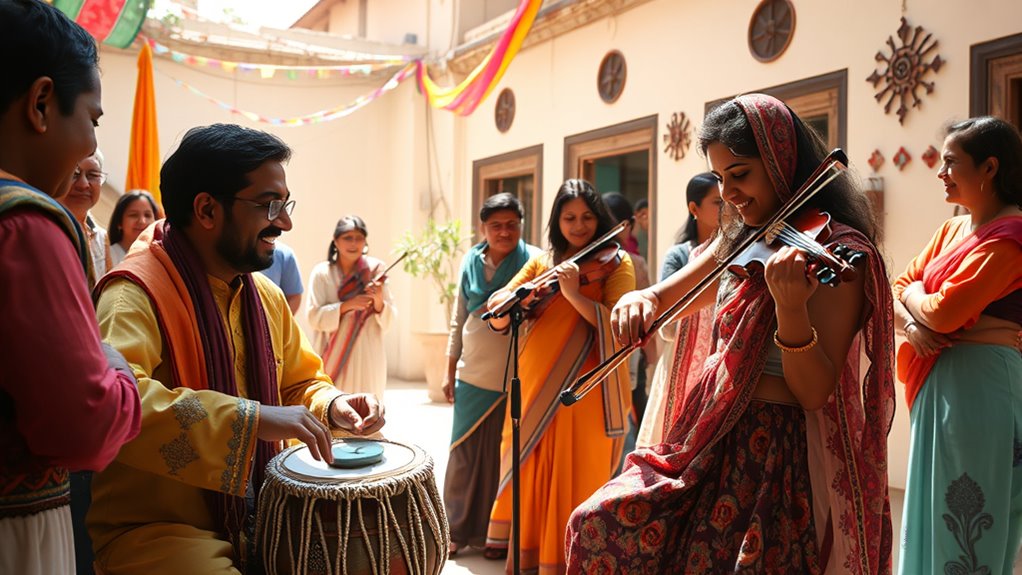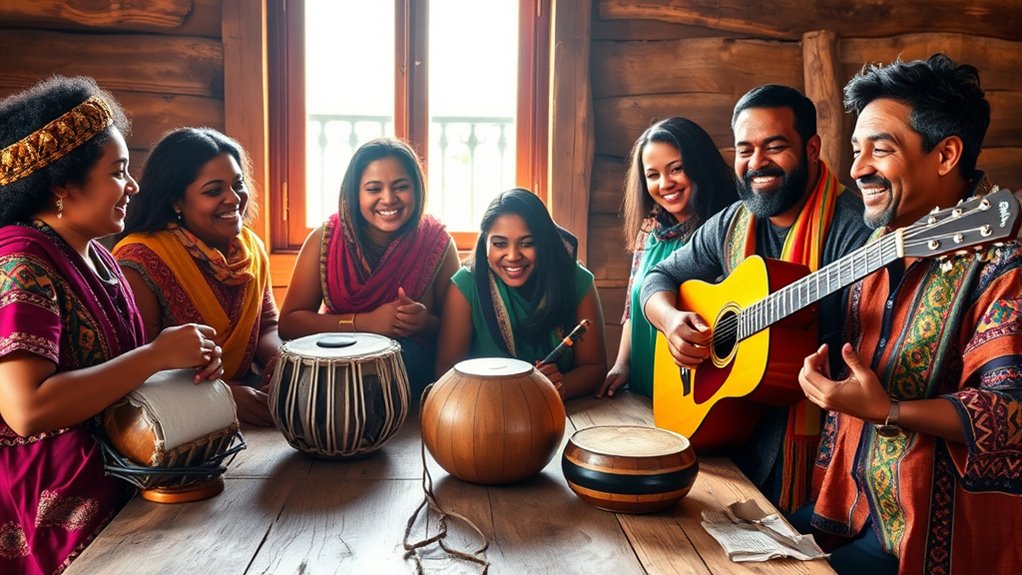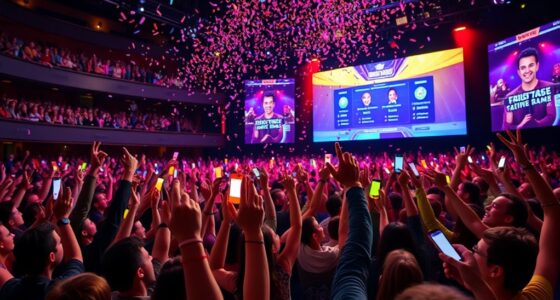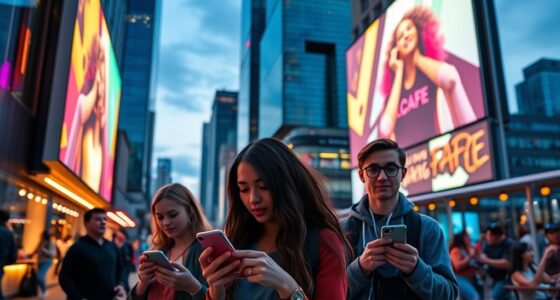Cross-cultural collaborations in music blend diverse genres and traditions, creating dynamic sounds that resonate with listeners worldwide. Musicians from different backgrounds fuse their styles and instruments, producing innovative tracks that showcase both traditional and contemporary elements. Globalization and digital platforms make these collaborations more accessible, fostering creativity and connection across borders. These partnerships not only break barriers but also promote understanding and inclusivity. There’s much more to explore about how these collaborations shape the music landscape.
Key Takeaways
- Cross-cultural collaborations blend diverse musical styles and traditions, creating innovative sounds that resonate with a wide audience.
- Artists utilize traditional instruments alongside modern production techniques, resulting in captivating and fresh musical experiences.
- Globalization and digital platforms facilitate real-time collaboration, allowing artists to share ideas across borders effortlessly.
- These partnerships challenge stereotypes and promote cultural understanding, fostering unity through shared musical expressions.
- Listener engagement through streaming and attendance helps sustain the movement of cross-cultural music, enriching the global cultural dialogue.

As the world becomes more interconnected, musicians are increasingly blending their cultural backgrounds to create unique sounds that resonate across borders. You might notice this trend in your favorite songs, where elements from various genres and traditions come together in surprising ways. These cross-cultural collaborations not only enrich the music but also create a shared space for listeners from different backgrounds to connect and celebrate diversity.
When artists from distinct musical heritages come together, they often fuse their styles to craft something entirely new. Imagine a hip-hop artist collaborating with a traditional sitar player; the result is likely to be a vibrant mix of rhythm and melody that captivates audiences far beyond their original cultures. You can hear this fusion in tracks that incorporate traditional instruments alongside modern beats, creating a soundscape that feels both familiar and fresh.
This blending of cultures is more than just a musical experiment. It’s a response to globalization, where accessibility to different musical influences has never been more crucial. You can find artists from various corners of the world collaborating through digital platforms, sharing ideas and sounds in real-time. This instant communication allows for innovative creativity that may have been impossible in the past. When you listen to these collaborations, you’re not just hearing music; you’re experiencing a dialogue between cultures.
Moreover, these collaborations challenge stereotypes and break down barriers. When artists choose to work together, they send a powerful message about unity and respect. You might find that tracks featuring diverse artists provide a fresh perspective and foster understanding. This is particularly important in a world where cultural divides can sometimes feel overwhelming. By engaging with these musical partnerships, you’re helping to bridge gaps and promote inclusivity.
You also play a crucial role in the success of these collaborations. Your support as a listener helps to elevate these artists, giving them the platform they need to thrive. By streaming, sharing, or attending concerts, you contribute to a growing appreciation for diverse sounds. As you immerse yourself in these cross-cultural collaborations, you become part of a larger movement that celebrates creativity and connection. Additionally, just as color accuracy is vital for enhancing visual experiences in home cinema projectors, the precision with which musicians blend their styles significantly impacts the richness of their collaborative sound.
In short, as you explore the world of cross-cultural collaborations in music, you’re not just discovering new sounds; you’re participating in a global conversation. Embrace this journey, and let the music guide you through the rich tapestry of human experience.
Frequently Asked Questions
How Do Cultural Differences Impact Musical Collaboration?
Cultural differences can greatly impact musical collaboration by influencing how you communicate, interpret rhythms, and approach creativity. You might find that varying traditions shape your songwriting process and performance styles. These differences can create unique sounds but may also lead to misunderstandings. By embracing diversity, you’ll discover new ideas and perspectives that enhance your music, fostering a richer collaborative experience. Ultimately, it’s about finding common ground while celebrating what makes each culture unique.
What Are Examples of Successful Cross-Cultural Music Projects?
Think of a beautiful tapestry woven from threads of different colors. That’s what successful cross-cultural music projects create. For instance, the collaboration between Yo-Yo Ma and the Silkroad Ensemble blends Western classical with Asian traditions, resulting in rich, innovative sounds. Similarly, the Afro-Cuban All Stars fuse jazz with Afro-Cuban rhythms, mesmerizing audiences worldwide. These projects show how diverse influences can harmonize, creating something truly unique and inspiring for everyone involved.
How Can Technology Facilitate Cross-Cultural Music Collaborations?
Technology makes cross-cultural music collaborations easier than ever. You can connect with artists worldwide through social media, video calls, and online platforms. These tools let you share ideas, sounds, and recordings instantly. By using software for remote collaboration, you can create and edit music together, regardless of distance. Streaming services also help you discover diverse influences, inspiring your projects. Embracing technology opens doors to innovative musical experiences and connections you might not have otherwise.
What Challenges Do Artists Face in Cross-Cultural Collaborations?
You’ll face several challenges in cross-cultural collaborations, like language barriers that can complicate communication. Different musical traditions and styles might clash, leading to creative conflicts. There’s also the risk of cultural appropriation, which can create tension and mistrust. Additionally, varying work ethics and expectations can hinder the collaborative process. Steering through these issues requires sensitivity, open-mindedness, and a willingness to compromise for a successful partnership.
How Can Audiences Engage With Cross-Cultural Music?
You can engage with cross-cultural music by exploring different genres and attending live performances. Try listening to playlists that mix various cultural sounds, and don’t hesitate to participate in discussions about the music’s backgrounds. You might find that sharing your thoughts on social media sparks intriguing conversations. Additionally, supporting artists through merchandise or streaming platforms helps promote their work, creating a vibrant community that celebrates diversity in music.
Conclusion
In the vibrant tapestry of music, cross-cultural collaborations weave together threads of diversity and creativity, transforming the ordinary into the extraordinary. By embracing these harmonious partnerships, you’re not just blending sounds; you’re celebrating the beautiful spectrum of human experience. So, let’s continue to dance to the rhythm of unity, where every note tells a story and every collaboration is a delightful journey. After all, in the world of music, the more, the merrier!









